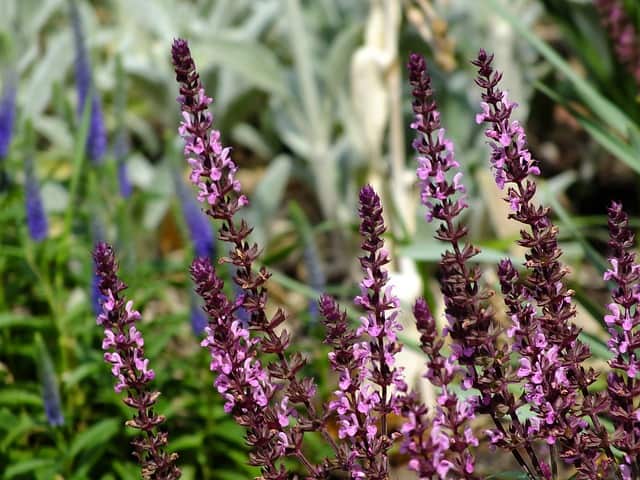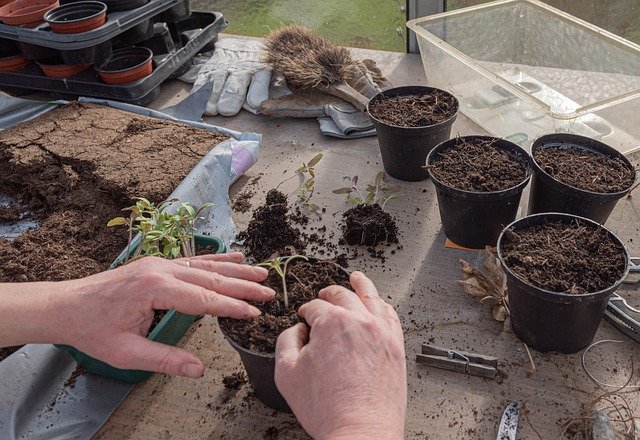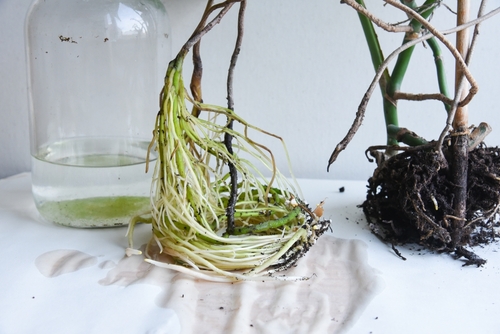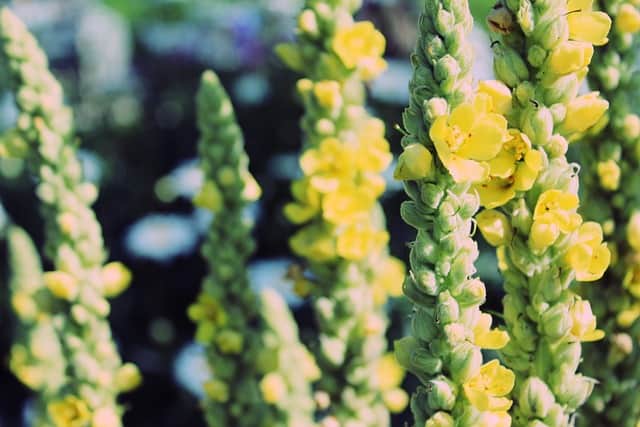Mullein and Lamb’s Ear are often mistaken for the same plant. They have similar fuzzy and hairy leaves that can confuse many people. However, they are completely different things on various levels since both plants belong to different botanic families.
Despite their similarities, the unique characteristics of mullein and Lamb’s Ear make them stand out on their own, providing distinct benefits to any garden or herbalist’s collection.
If you want to grow plants yourself and want to know the difference between them, keep reading.
Mullein vs Lambs Ear

Mulleins are biennial plants whereas lamb’s ear is a perennial plant. Their leaves can appear very similar to each other during the first year of a mullein’s growth.
However, in the second year, the mullein produces a vertical shoot of flowers. This growth can be 2m tall or more whereas the lamb’s ear continues to grow close to the ground.
When we talk about mulleins, we aren’t talking about a specific plant or species. Instead, mullein is an entire genus of plants. There are over 450 species of flowering plants in the Verbascum genus, all of which are called mulleins.
Comparison
| Mullein | Lambs Ear | |
| Leaf Color | Grayish-green | Whitish/silverfish-green |
| Stem Color | Gray or green with small fuzzy hairs | silver or gray with fuzzy haired leaves |
| Variegation | No variegation | Striped Phantom |
| Flower | Pink, yellow, or blue | Purple/ pink |
Other similar comparisons:
Mullein vs. Lambs Ear Differences
Despite the obvious similarities between mullein vs lambs ear in its first year of growth, there are many differences between the two plants. Mulleins are mostly an invasive species that can invade the rest of your garden whereas lamb’s ear is relatively less aggressive. Here are the main differences between these plants.
1. Origin and Name
The word mullein comes from the Anglo-French word ‘mol’ meaning soft. The name represents the soft texture of the plant’s leaves. The plant was originally cultivated in North Africa and the Mediterranean regions. However, it is now widely cultivated in Europe, North America, and Australia.
Lamb’s ear’s name comes from the curved shape of its leaves with white soft hairs. Lamb’s or donkey’s ear was originally found in some parts of Turkey and Iran. However, nowadays you can find it almost all over the world as a houseplant.
2. Taxonomy
Mulleins or the Verbascum genus is a part of the Scrophulariaceae family. Mullein and its many species are a big part of this family. There are 450+ different species in the mullein genus.
Lamb’s Ear, or Stachys byzantina, belongs to the Lamiaceae family. Lamiaceae is a family of mints that includes over 7,000 different members.
3. Shape and Appearance

The lamb’s ear is popular for its lovely leaves with attractive fuzz covering both the leaves and the stem. A blossoming lamb’s ear has a small flower spike that extends up from the center of the plant.
The Mullein plant also has leaves and stems covered by smooth silverfish fuzz. However, they are less dense compared to the lamb’s ear. Mullein plants look very similar to lamb’s ear in the first year of their growth but develop a very tall flower spike in the second year.
4. Differences in Color
The standard color of lamb’s ears is whitish or grayish green. However, its foliage and flower can be of various colors, including pink, blue, green, and white.
Mullein has a wide range of variations since there are so many species of mulleins. However, the most common mullein, the Verbascum thapsus, has light-green leaves with a thin layer of silver hairs on top.
5. Leaf Size and Texture
The lamb’s ear’s leaves are very smooth to the touch thanks to the silver hairs that cover the leaves. Each leaf can be up to 6 inches (15 cm) in length.
The leaves of the mullein plant are oval with soft fuzz on their surface. They have large leaves that can reach up to 38 cm in length. Their texture is less soft as compared to the lamb’s ear.
6. Height and Growth Rate
Lamb’s ears are usually between 1ft-2.5ft (30cm-80cm) in height. The Lamb’s ear has a moderate speed of growth. Most of the lamb’s ear’s height comes from its flower spikes.
Year 1 mulleins are relatively equal to a lamb’s ear in height however during the second year of growth, their flower spikes can reach up to 2m in height. They grow at a moderate speed during the first year but speed up during the second year.
7. Flowers

Lamb’s ear has beautiful and colorful small flowers. Its flowers can be purple or pink with a good fragrance. They bloom during the summer.
Mullein flowers appear in the second year of their life cycle. They are usually golden or bright yellow. However, some varieties of mulleins can have pink flowers.
8. Growing Conditions, Temperature and Climate
Lamb’s ear can thrive in USDA zone 4-8. It prefers cold climates and temperatures and dies in areas with high humidity and hot climates.
Mullein plants require 3-9 hardiness zones. They are less sensitive to heat however they are still vulnerable to very hot climates in summer. Despite being cold hardy, mulleins can’t tolerate temperatures below -15°C.
9. Light, Water, Soil
Lamb’s ear can thrive in a low-light environment but it can also tolerate direct sunlight. It only needs a bit of water and doesn’t like being overwatered. You’ll need very well-drained, slightly acidic soil with a pH between 6.0-6.5 to properly grow a lamb’s ear.
Mulleins also prefer well-drained soil but they have more tolerance to environmental conditions. They need direct sunlight for proper growth and don’t need much water. However, it is recommended you maintain moderately wet soil.
Mullein vs Lambs Ear Similarities
Despite the presence of obvious differences, there are still some minor similarities between both plants. These similarities are why people often confuse these completely different plants. Some of these similarities are in the way these plants are grown and maintained.
1. Watering
Both plants thrive on very little water. You’ll only need to water your plants with 1 inch of water every week. Mulleins do need a bit of moisture in the soil so you can water them a bit more. However, both plants are drought-tolerant and should not be watered unless the soil is dry.
2. Humidity and Temperature
Mulleins can withstand harsh weather compared to the lamb’s ear. Both plants can’t survive in a tropical climate with above-average temperatures and humidity. These plants prefer slightly cold climates with minimal humidity.
3. Potting and Soil

Both plants prefer well-drained soil. Although Mulleins prefer a slightly alkaline soil and lamb’s ear prefers slightly acidic soil, you can grow both plants in a neutral pH soil without affecting their growth too much.
You can easily keep both plants in standard pots with dry or clay soil. You can also transfer them into bigger containers if you wish to keep them in your home garden but don’t place them near plants that need much moisture.
4. Fertilizer
Mulleins and lamb’s ear do not require soil with rich nutrients. However, if you want to boost their blooming in the spring, you can add a bit of compost at the beginning of the season. The best time to add fertilizer is early spring since these plants are growing the fastest at that time.
5. Natural Habitat
Mullein is grown in various regions across the world, as it can tolerate cooler weather compared to lamb’s ears. It was, however, a native plant of southwest Asia, Europe, and northern Africa. It was transmitted to North America, Australia, and New Zealand as an invasive species.
Lamb’s ear, on the other hand, is native to the region of Eurasian in countries like Armenia, Georgia, and Turkey. It is also found in Iran and Uzbekistan. However, it is now grown in countries other than the Middle East and Eurasia. However, both of these plants can be grown anywhere in the world outside of the tropics.
Common Problems for Both Plants
Caring for these two plants is generally problem-free. They can resist drought and moderate coldness. However, you might face minor issues if you miss the proper care routine.
1. Root rot

This is a common disease that affects overwatered plants. Overwatering can happen easily if you are planted in poorly-drained soil. The disease starts at the roots but goes all the way to the leaves and foliage.
Root rot can be potentially lethal to your plant and attracts many pests. If your plant is affected by root rot, it is recommended you repot it after pruning away any infected roots to prevent the disease from spreading. Avoid overwatering to prevent root rot.
2. Spotted leaves
Spotted leaves are a disease caused by fungus. The leaves of an infected plant develop colorful spots that can be white, black, or brownish. Spotted leaves attract other pests that can harm your plant. To treat an affected plant, remove all infected leaves and spray the plant with a fungicide.
3. Pest Infestations
Like most houseplants, mullein and Lambs ear can suffer from pest attacks. Aphids, snails, and spider mites are some of the pests that infest these plants. Without proper care and attention, these pests can destroy the plants’ leaves, thereby making the plant weak and unattractive. Monitoring your plants regularly and applying pesticides can help prevent pests from attacking them.
4. Environmental Stress
While both mullein and Lambs Ear can survive in extreme weather conditions, they can’t tolerate severe cold weather conditions. If you keep these plants in places that are too cold, they may experience stress. Also, if their soils are continually wet, the plants may suffer from root rot. During the cold months, consider applying mulch to the plants’ roots to protect them from damage.
5. Diseases
Mullein and Lambs Ear are susceptible to several diseases if they don’t receive proper care. Some of the diseases that can affect these plants include fungal diseases, bacterial diseases, and viral diseases. Fungal diseases can cause powdery mildew, leaf spot, and root rot in both plants.
Symptoms of bacterial diseases in these plants include dark leaf spots and the dropping of leaves. Viral diseases can cause leaf discoloration and stunted growth in mullein and lambs ear plants.
Ensure your plants are healthy by providing them with the necessary requirements to prevent disease infections.
Outro
Whether you go for mullein vs lambs ear, they will be a great addition to your home garden. They are both easy to grow and can last a very long time.
Be careful not to overwater them or leave them unattended in extremely hot or cold climates. Lamb’s ear is better for herbal use while mulleins are easier to grow as houseplants.
Frequently Asked Questions
Are mullein and lamb’s ears the same?
No, mullein and lamb’s ear are completely different plants from different families. They are not the same size, even though both plants have leaves covered in smooth, white, or grayish fuzz.
A mature mullein plant can be 2 meters tall while the tallest flower spikes of a lamb’s ear plant are around 50 cm. Lamb’s ear is a perennial and evergreen plant while mullein is biennial and has no evergreen foliage.
Is there a plant that looks like mullein?
Foxglove (Digitalis purpurea) looks almost identical to the mullein but it is a poisonous plant. They have slightly serrated dark-colored leaves that also have silvery hair on their leaves.
Does lamb’s ear have any medical properties?
Yes, there are numerous medicinal uses for this herb. It was commonly used to treat the wounds and injuries of warriors on the battlefield due to its ability to stop bleeding and hasten the formation of clots.
Its fur-like layer on the leaves can absorb blood, and the lamb’s ear has shown amazing properties as an anti-inflammatory herb. It was also used for its antibacterial properties in many cultures.

Hey, I’m Lisa and I’ve been an avid gardener for over 30 years. I love writing, talking and living in the garden! Feel free to connect with me on my socials below


